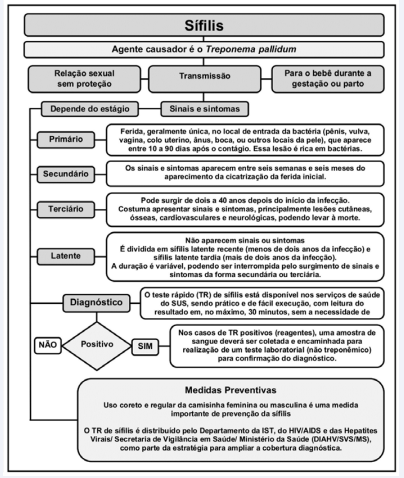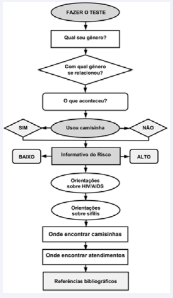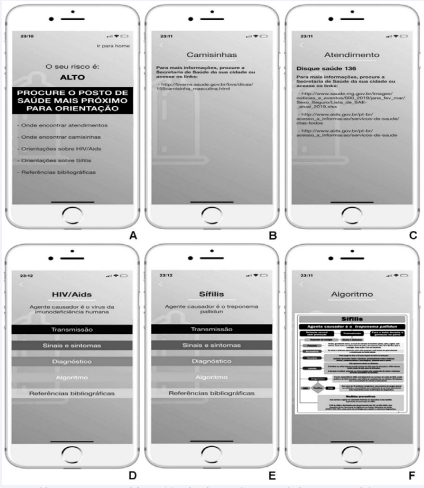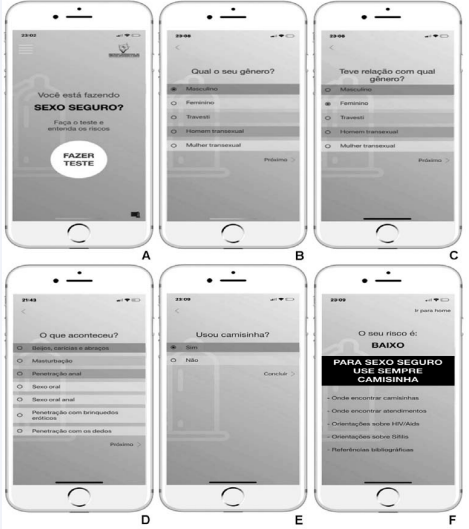Application for teenagers: preventing sexually transmitted infections Aplicativoadolescentes: preven
- 1. Department of Applied Health Care, Universidade do Vale do Sapucaí (UNIVÁS), Brazil
- 2. Centro Universitário Serra dos Orgãos (UNIFESO), Brazil
- 3. Eye Bank of the Hospital Universitário Alzira Velano, Brazil
ABSTRACT
Objective: Unprotected sexual activities make teenagers susceptible to sexually transmitted diseases. The aim of this study was to describe the development of a mobile application to inform teenagers about the risks and prevention of human immunodeficiency virus infection/acquired immunodeficiency syndrome (HIV/AIDS) and syphilis.
Methods: An integrative literature review was conducted in health sciences databases to verify the need for development of the instrument, identify risk factors for HIV/AIDS and syphilis among teenagers, and create a preventive care plan for teenagers.
The construction of the mobile application involved the creation of a decision tree, database structuring, and software development. The developed application has 47 screens describing procedures for risk assessment and prevention of HIV/AIDS and syphilis. It was tested for functionality using usability, performance, compatibility, and functional tests.
Results: The mobile application called SexoSeguro App was created to provide information for teenagers about risks and prevention of HIV/AIDS and syphilis, and will be freely available online (App Store and Play Store).
CITATION
: Leão AS, Salomé GM, Leão-Centro JPP, Pereira Leão DM, Cardoso IA, et al. (2020) Application for teenagers: preventing sexually transmitted infections Aplicativoadolescentes: prevenção de infecções sexual mentetransmissíveis. Ann Nurs Pract 7(1): 1108
KEYWORDS
Sexually transmitted diseases, Acquired immunodeficiency syndrome, Human immunodeficiency virus, Syphilis, Mobile applications
INTRODUCTION
Adolescence is characterized by a period of discovery, sexual experimentation and development of autonomy. However, in the field of sexuality, teenagers lack experience and maturity. Imbued by the desire to be adults and the pursuit of early initiation into sexual activity, they are culturally influenced by the media to behave in ways that make them vulnerable to sexually transmitted diseases [1,2].
Sexually Transmitted Infections (STIs) are serious illnesses caused by viruses, bacteria or other microbes transmitted primarily through unprotected sex with an infected person, and usually result in wounds, discharge, blisters or warts [2,3]. Some STIs may have no symptoms in both men and women. Thus, individuals who have unprotected sex should seek health care to consult a health professional. These diseases, when not diagnosed and treated in time, can lead to serious complications such as infertility, ectopic pregnancy, cancer and even death [2- 7].
There are over 1.8 billion teenagers in the world today; the largest generation in history [8].This population is highly vulnerable to sexual and reproductive health problems and to STIs, including the human immunodeficiency virus/acquired immunodeficiency syndrome (HIV/AIDS) and syphilis [8]. STIs have gained importance as a global public health problem following the AIDS epidemic in the 1980s. The World Health Organization (WHO) estimates that 333 million cases of curable STIs happen each year, with more than two thirds of these cases occurring in developing countries [9].
In Brazil, four out of every ten youths are between 15 and 29 years old, totaling 50 million people.9Between 1980 and 2012, 72,161 cases of AIDS among young people were identified in Brazil, of which 14,724 (20.4%) involved youths aged 10 to 19. Data on the prevalence of other STIs among the young Brazilian population are still insufficient. However, the overall trend points to a higher prevalence of genital herpes and human papillomavirus (HPV) infection, with 17% and 25% of cases reported in the 10 to 24 year-old range, respectively. Due to the high rates of STIs among Brazilian youth and teenagers, contributions to the field of sexual and reproductive health should be made at both health prevention and health promotion levels [9].
A worldwide increase in the use of mobile apps in healthcare has grown in parallel with the popularity of mobile devices among the general population [7]. It was estimated that there were more than 7 billion cellphones active at the end of 2015, surpassing all other telecommunications technologies [7].
Young people often report being discriminated against by health professionals when seeking specialized services, and because they feel stigmatized, communication with adults about STIs is difficult. This increases their difficulties in obtaining comprehensive and quality information regarding their sex life, especially about HIV and other STIs [10,11]. In this challenging scenario, providing information through alternative means to reach young people is extremely important and necessary. Providing information on STI and HIV through mobile technology has become an acceptable, viable and promising source of intervention and can positively influence the attitudes of this population, reducing risky sexual behaviour and increasing the frequency of health service visits [10,11].
The potential benefits of using mobile devices and other mobile devices are being explored globally. In 2011, 83% of the 112 WHO member countries reported hosting at least one mobile health initiative, corresponding to 77% of low-income countries and 87% of high-income countries [7]. The use of mobile apps is a good way to reach a large number of teenagers in different contexts, with the particular and essential goal of providing high quality and comprehensive information and support to this population [10-12].
Therefore, this study aimed to describe the process of developing an application to guide teenagers about the risks and prevention of HIV/AIDS and syphilis.
METHODS
This study was applied in the technological production modality, of the methodological development research type. It was approved by the Research Ethics Committee of the Medical Science College Dr. José Antônio Garcia Coutinho of the University of Vale do Sapucaí (UNIVÁS), under the Consubstantiated Opinion no. 2,557,228.
As a methodology for the development of multimedia application software, we opted for using Contextualized Instructional Design, which involves a constructivist proposal and consists of the intentional action of planning, developing and applying specific didactic situations, incorporating mechanisms that favour contextualization [13]. The development of the multimedia application for mobile platforms shown here followed the Analysis, Design, Development, Implementation and Evaluation steps.
The Analysis phase consisted of selecting information that would allow researchers to identify risk factors for teenagers regarding exposure to HIV/AIDS and syphilis, and to develop a preventive care plan for them. To this end, an integrative literature review was conducted using health sciences databases, such as the Scientific Electronic Library Online (SciELO), Latin American and Caribbean Health Sciences Literature (LILACS) and the Medical Literature Analysis and Retrieval System Online (MEDLINE), in addition to the Google Scholar search tool.
The Design stage involved the planning and production of didactic content, the definition of topics and content writing, the selection of media and the design of the interface (layout). The use of texts structured in topics and connected by hypertext (links) was chosen for this process.
Development comprised the selection of multimedia application tools, the construction of two algorithms (for HIV/ AIDS and syphilis prevention, respectively) and the decision tree, the definition of the navigation structure, and the planning of environmental setups (Figures 1-3).

Figure 1 Final version of the Human Immunodeficiency Virus/Acquired Immunodeficiency Syndrome (HIV/AIDS) Prevention and Treatment Algorithm.

Figure 2 Final version of the Syphilis Prevention and Treatment Algorithm.

Figure 3 Decision tree for building the multimedia application to guide teenagers on risks and prevention of human immunodeficiency virus/acquired immunodeficiency syndrome (HIV/AIDS) infection and syphilis.
In the Implementation stage, the didactic tools and educational technological resources were configured, and an environment for the online download of the application and its installation on mobile devices was created.
In the Evaluation phase functionality tests were performed, which included usability, performance, compatibility and functionality tests [14,15] as described below.
The usability test verified whether the user could intuitively use the software from the initial screen to the final one. The project authors used the software five times, carrying out and browsing: the initial access to the software, risk combinations for adolescents regarding HIV/AIDS and syphilis, risk selection, information on the characteristics of each condition, causes and types of conditions, an informational document and links to how and where to seek recommended testing and prevention, and texts to know more about these conditions.
Performance testing was done to assess responsiveness after each command was carried out. During the use of the software, a systems analyst and the authors of the study verified startup time, screen change time and software completion time, taking into account each of the different screens.
The compatibility test was applied to confirm the operational status of the internal functions of the application on different devices. For this test, a few mobile devices with iOS or Android operating systems, in addition to Wi-Fi for wireless network access, were chosen.
The functional or black box test was performed to confirm that a series of internal functions of the application were working properly. This test was conducted by the systems analyst.
The entire testing process was attended by the authors and systems analyst. The application was made available to the user only after the necessary tests and corrections were made.
RESULTS
Two algorithms, one for HIV/AIDS prevention (Figure 1) and another for syphilis prevention (Figure 2) and a decision tree (Figure 3) were built to serve as the basis for the development of the mobile application.
The final version of the multimedia application for mobile platforms developed in this study, called Sexo Seguro App (Safe Sex App), has 47 screens that describe the risk assessment and prevention procedures for HIV/AIDS and syphilis for teenager counseling. The mobile application was entered into the computer records of the National Institute of Industrial Property (INPI, Ministry of Development, Industry and Foreign Trade of Brazil). It will be available for free on the Apple App Store and Google Play Store once registration with INPI is complete.
The first screen of the application (Figure 4, screen A) invites the user to take the test. By clicking the Take Test icon, the user will start a 15-screen sequence where they can identify the risks of acquiring HIV/AIDS and syphilis. This step is exemplified in Figure 4 (screens B-E). After the user indicates the risk factors to which they have been exposed, the software will determine his/her degree of risk (low or high) of acquiring HIV/AIDS and syphilis, which will be displayed on the screen (Figure 4, screen F; or Figure 5, screen A) when the user clicks the Finish icon. The user can then get information on where to find condoms and where to seek care, as well as guidance on HIV/AIDS and syphilis. To view this information or guidance, the user will have to click on the desired links.

Figure 4 Sample screens of the SexoSeguro App mobile app. (A) Home screen inviting the user to take the test; (B-E) identification of risk factors for human immunodeficiency virus/acquired immunodeficiency syndrome (HIV/AIDS) infection and syphilis to which the user has been exposed; and (F) low risk indicator screen for acquiring HIV/AIDS and syphilis
For example, the user can get information about the nearest health centers (Figure 5, screen B) or where to find care by calling the Disk Saúde phone number and accessing the Ministry of Health link that informs about centers for consulting nationwide (Figure 5, screen C). The user will also find general information on the etiology, symptoms, tests and preventive methodsagainst HIV/AIDS (Figure 5, screen D) and syphilis (Figure 5, screen E), and can access, for example, the algorithm for prevention and treatment of syphilis (Figure 5, screen F)

Figure 5 Sample screens of the SexoSeguro App mobile app. (A) High-risk screen for acquring for human immunodeficiency virus infection/acquired immunodeficiency syndrome (HIV/AIDS) infection and syphilis; (B) information about nearest health centers; (C) information on Disk Saúde access and care facilities nationwide; general information on (D) HIV/AIDS and (E) syphilis; and (F) syphilis prevention and treatment algorithm as an example of available information (same algorithm as Figure 2).
DISCUSSION
The choice of the theme of SexoSeguro App came after researchers observed in clinical practice that teenagers have prematurely started sexual practice, with partner variability and without consistent condom use associated with sexual freedom, leaving them vulnerable to sexually transmitted infections. Teenagers represent the earliest group of horizontal transmission. They often do not rely on close relatives to talk about these subjects and seek out people who are not knowledgeable of the topic or go to web pages to read about it. However, many of these sites are not scientifically-based. Concern about the quality of online course content and applications has led to the development of the Sex Safe App with the purpose of providing effective, quality and timely guidance to teenagers based on risk assessment as well as information on HIV/AIDS and syphilis prevention.
The development of new health tools requires the incorporation of new technologies. In this study, this was done by developing an application that provides information and guidance to teenagers regarding the risks and prevention of HIV/ AIDS and syphilis. Applications are increasingly being used in healthcare. Online stores offer various software with options in several languages, most of them in English. These options grow every day and range from fitness systems to monitoring and control of various diseases, and when well-designed and used, are teaching tools that can bring benefits to patients, caregivers and professionals [16-18].
Similar studies conducted in Brazil about the use of mobile applications aimed at the clinical practice to treat various diseases highlight the importance of investing in this field of research, and that their development should be based on scientific evidence [12,19-20]. Software developed for this purpose must have functionalities, be easily accessible and include information regarding preventive methods and treatments, as well as the speed and accuracy of tests and diagnosis methods [12,19-20]. These can also be provided with functions that bring users (clients) closer to health professionals, contributing to adherence to therapy, preventive actions and care, reminding the client to take medications, as well as helping health professionals to be more effective when giving theoretical and practical information [16-18,21-23] To develop an application clearly and objectively, it is essential to recognize user needs, making the end product meet specific demands, tested in research and implemented in clinical practice [16-18,21-23].
Unlike currently available apps that mostly address theoretical aspects and have little to do with clinical practice, the SexoSeguro Apphas been designed so that the information on each screen is clear, objective and simple for teenagers, seeking to meet the needs of this population as regards HIV/AIDS and syphilis prevention and risk assessment. This application is a technological innovation in health, as it is the first mobile application developed in Brazil to provide information and guidance to teenagers about HIV/AIDS and syphilis prevention, and that will be available for free on the App Store and Play Store in Portuguese.
Many studies show that there are a number of innovative information and behavioural change technologies that provide information and guidance to teenagers about safe sex, among which is the use of cellphones [11,24].
An exploratory study aimed at identifying available mobile phone applications on HIV /AIDS24found 5 applications in English and 15 in Portuguese, 6 of which were developed by the Department of Informatics of the Unified Health System (DATASUS) of the Ministry of Health, 3 by the Municipal Health Secretariat of São Paulo, 1 by the Health Secretariat of the State of São Paulo, 1 by the Municipal Health Secretariat of Curitiba, 1 by the Health Department of the State of Pará and 2 by private entities. None of these applications have been developed based on a literature review and none of them are teenager-specific [24]
The SexoSeguro App gives users quick access via smart phones and tablets to answer questions related to HIV/AIDS and syphilis. The information contained in this app was based on manuals from the Ministry of Health and on national and international articles. After the application was developed, functionality tests were performed by the researchers and computer programmers, and it was made available on the Internet to the user only after the correction of detected problems. Software functionality testing is critical to identifying product weaknesses and limitations, analyzing performance and diagnosing the need for adaptations. This assessment is consolidated by specific standards such as the International Organization for Standardization (ISO), International Electrotechnical Commision (IEC) and the Brazilian Association of Technical Standards (ABNT),which proposed two Brazilian Standards (NBRISO/IEC 14598-1andNBR ISO/IEC 9126-1) [14,15] dealing with the quality of software products. Such standards have been used for the creation of software and their evaluation in different health contexts [26,27].
CONCLUSION
In conclusion, this study described the planning and development steps of a mobile platform multimedia application called Sexo Seguro App for the effective and proper guidance of teenagers in a timely manner, by providing risk assessment and information on HIV/AIDS and syphilis prevention.








































































































































